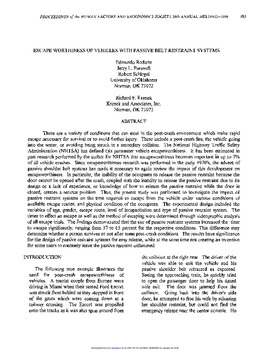| dc.contributor.author | Edmundo Rodarte | |
| dc.contributor.author | Jerry L. Purswell | |
| dc.contributor.author | Robert Schlegel | |
| dc.contributor.author | Richard F. Krenek | |
| dc.date.accessioned | 2016-01-14T19:53:50Z | |
| dc.date.accessioned | 2016-03-30T15:35:07Z | |
| dc.date.available | 2016-01-14T19:53:50Z | |
| dc.date.available | 2016-03-30T15:35:07Z | |
| dc.date.issued | 1994-10-01 | |
| dc.identifier.citation | Rodarte, E., Purswell, J. L., Schlegel, R., & Krenek, R. F. (1994). Escape Worthiness of Vehicles with Passive Belt Restraint Systems. Proceedings of the Human Factors and Ergonomics Society Annual Meeting, 38(14), 893-897. doi: 10.1177/154193129403801421 | en_US |
| dc.identifier.uri | https://hdl.handle.net/11244/25476 | |
| dc.description.abstract | There are a variety of conditions that can exist in the post-crash environment which make rapid escape necessary for survival or to avoid further injury. These include a post-crash fire, the vehicle going into the water, or avoiding being struck in a secondary collision. The National Highway Traffic Safety Administration (NHTSA) has defined this parameter vehicle escapeworthiness. It has been estimated in past research performed by the author for NHTSA that escapeworthiness becomes important in up to 7% of all vehicle crashes. Since escapeworthiness research was performed in the early 1970's, the advent of passive shoulder belt systems has made it necessary to again review the impact of this development on escapeworthiness. In particular, the inability of the occupants to release the passive restraint because the door cannot be opened after the crash, coupled with the inability to release the passive restraint due to its design or a lack of experience, or knowledge of how to release the passive restraint while the door is closed, creates a serious problem. Thus, the present study was performed to investigate the impact of passive restraint systems on the time required to escape from the vehicle under various conditions of available escape routes, and physical condition of the occupants. The experimental design included the variables of age, gender, escape route, level of incapacitation and type of passive restraint system. The times to effect an escape as well as the method of escaping were determined through videographic analysis of all escape trials. The findings demonstrated that the use of passive restraint systems increased the time to escape significantly, ranging from 37 to 65 percent for the respective conditions. This difference may determine whether a person survives or not after some post-crash conditions. The results have significance for the design of passive restraint systems for easy release, while at the same time not creating an incentive for some users to routinely leave the passive restraint unfastened. | en_US |
| dc.language.iso | en_US | en_US |
| dc.publisher | Proceedings of the Human Factors and Ergonomics Society Annual Meeting | |
| dc.title | Escape Worthiness of Vehicles with Passive Belt Restraint Systems | en_US |
| dc.type | Research Article | en_US |
| dc.description.peerreview | Yes | en_US |
| dc.description.peerreviewnotes | https://us.sagepub.com/en-us/nam/manuscript-submission-guidelines | en_US |
| dc.identifier.doi | 10.1177/154193129403801421 | en_US |
| dc.rights.requestable | false | en_US |
